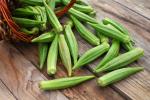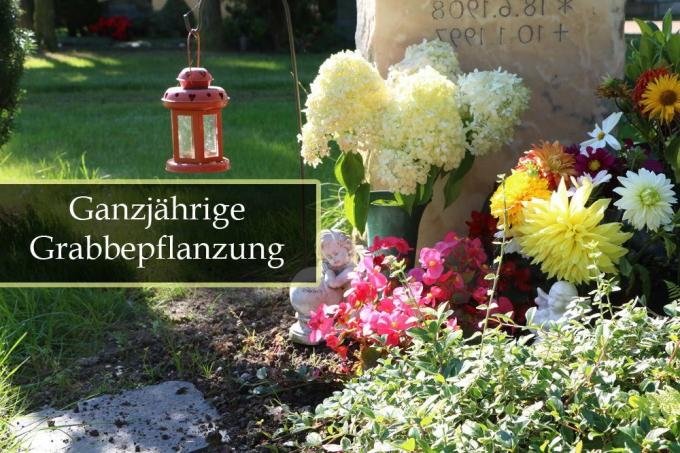
table of contents
- Year-round grave planting
- Ground cover
- from B - E
- from K - W
- Shrubs and high stems
- from B - L
- from M - Z
- Bulb plants
- Perennials
- from C - E
- from F - H
A well-tended grave is part of coping with grief. It is a place of retreat and peace for the bereaved, but at the same time honors the deceased. Therefore, the grave planting should look well cared for all year round. Those who do not have a lot of time for care can fall back on year-round grave planting that does not require a lot of care. There are many easy-care plants that can be used to decorate a grave.
Year-round grave planting
As a rule, a grave site is not visited every day in order to maintain it. Because usually there is simply simply not enough time for this. But it is important that a grave has a year-round decorative look, because this is where the Honored the deceased and the bereaved need a place for their loved ones Coping with grief. In a cemetery it is usually quite shady, as many trees keep the blazing sun out, so that the graves are mostly in the shade. This should definitely be considered when planting. However, there are some easy-care plants for year-round grave planting that have been listed according to the following criteria:
- Ground cover
- Shrubs and high stems
- Bulb plants
- hardy summer and autumn flowering perennials
Note: Perhaps you should also look at the other graves on the sides. Because it is often the case that a reasonably uniform planting is desired in a cemetery. Therefore, not all plants may be desirable. If you are unsure, contact the administration or the responsible gardener.
Ground cover
Ground covers are a good option for easy-care grave planting all year round. When purchasing, you should pay attention to evergreen plants that bloom during the warm months. This is how it looks Dig in winter too not too dreary and in summer colorful flowers show up on the green carpet. The following are some of the ground covers that do well in the shade and produce beautiful blooms:
from B - E
Ground cover rose
- belongs to the small shrub roses
- area-wide spread
- frost hardy
- blooms permanently
- from May to September
- Flowers of different colors
- prefers well drained and loose soil
- needs a lot of nutrients
- regular fertilization
- if too high it has to be cut
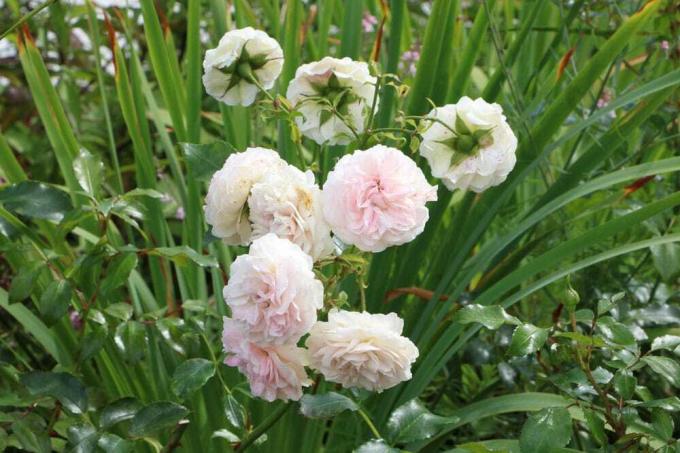
Dickman (Pachysandra terminalis)
- Boxwood family (Buxaceae)
- native to Japan and China
- Flower color white
- Flowering from April to May
- Loamy-sandy, humus-rich and nutrient-rich soil
- hardy
- grows flat
- forms carpet
- water regularly and moderately
- sensitive to lime

Ivy (Hedera helix)
- Home Asia and Europe
- Sticky roots to climb
- well suited as a ground cover
- only cultivate in the shade
- evergreen
- old plants form spherical yellow umbels
- then black fruits in winter
- good bird food
- moist and well drained soil
- There is no need to fertilize outdoors

Elven flower (Epimedium)
- Barberry family (Berberidaceae)
- also known as pedestal flowers
- native to North Africa, Asia and the Mediterranean
- Good ground cover even with a height of 30 centimeters
- has subshrub character
- evergreen and winter-naked varieties available
- Soil always slightly dry
- Soil poor in humus, few nutrients
- filigree stems with small flowers
- flowers before the new shoots in spring
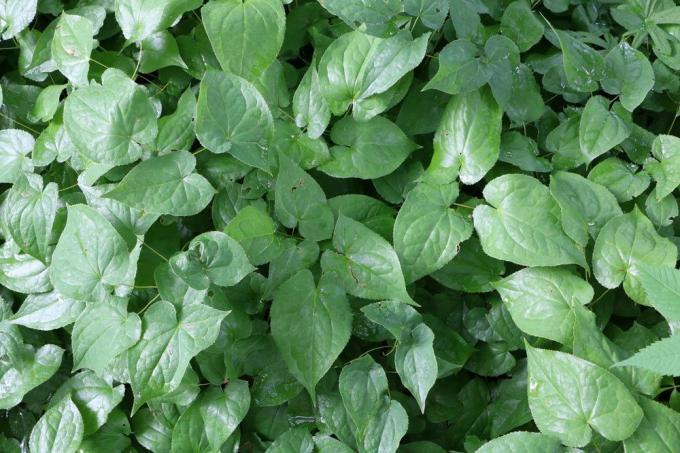
from K - W
Lesser periwinkle (Vinca minor)
- Dog poison family (Apocynaceae)
- widespread from Europe to West Asia
- toxic in all parts
- Flowering between April and May
- Color white and blue-violet
- loose and nutrient-rich soil
- prefers cool and damp places
- glossy, dark green leaves
- hardy
- Cut is not needed

Creeping spindle (Euonymus fortunei)
- Spindle tree family (Celastraceae)
- also known as climbing spindles
- original home of China
- Flowering time in June and July
- Flower color white to green
- hardy
- evergreen
- robust and very durable
- moist and dry soil is tolerated
- Soil humus and rich in nutrients

Chickweed (Stellaria)
- Carnation family (Caryophyllaceae)
- belongs to the spring bloomers
- wild growth on forest edges
- sheltered location
- Soil poor in lime, humus and loamy-sandy
- alkaline to acidic pH values
- develops petals in white
- continuous carpet of flowers from spring to summer
- Water regularly in dry periods
- hardy
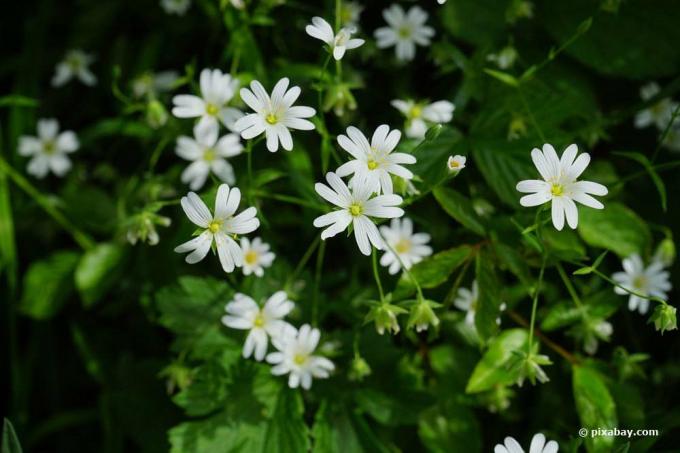
Loquat (Cotoneaster radicans)
- based in China
- also known as crawfish
- evergreen
- easy-care
- Prevent spread by cutting
- Flowering from May to June
- Flowers white and small
- produces unsuitable red berries in autumn
- Soil humus and rich in nutrients
- natural rain is enough

Waldsteinie (Waldstenia ternata)
- also known as goldberry
- shady location only a few flowers
- Flowers turn yellow in April and May
- Water must be free of lime
- Keep the soil moist at all times
- fertilize moderately
- Mix compost with horn shavings
- hardy
- brownish-red autumn and winter colors
- when new leaves emerge in spring, old leaves are thrown off
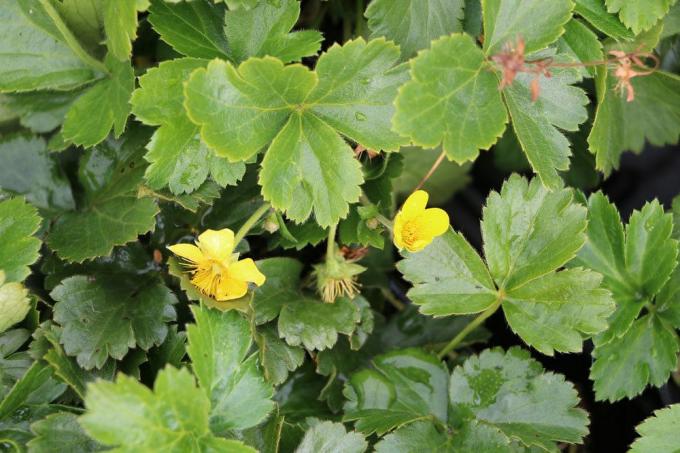
Shrubs and high stems
As a small grave border, as a planting behind the tombstone or as a small solitaire in the middle of the Small, evergreen, year-round shrubs that are also raised to a high stem are suitable for graves can. These include the following, easy-care plants:
from B - L
Boxwood (Buxus)
- Boxwood family (Buxaceae)
- Spread from Central Europe across Africa to East Asia
- undemanding tree / shrub
- location protected from midday sun
- tolerates prolonged drought
- can be cultivated as a standard stem or shrub
- Can be cut in many different shapes
- calcareous, loamy soil
- Beware of the box tree moth

Japanese pine (Pinus densiflora)
- originally from Japan
- different types available
- evergreen needles
- are up to twelve centimeters long
- round, compact crown
- Sunny to partially shaded location
- sandy and well drained soil
- Cut is not necessary
- hardy
- slow growth
Tree of Life (Thuja)
- Cypress family (Cupressaceae)
- originally native to North America and East Asia
- not only usable as a hedge
- evergreen grave planting
- sunny to partially shaded location
- always slightly moist soil
- Summer drought is not tolerated
- Chalky, sandy loam soil preferred
- regular pruning required
- can be cut into shape
- frost hardy

from M - Z
Shell cypress (Chamaecyparis obtusa)
- originally from Japan
- multi-stemmed cypress family
- very slow growth
- not higher than 2.50 meters even in old age
- Shell-shaped crown shaped to the ground
- Shady location ideal
- well drained, moist, humus soil
- acidic soil such as that of the rhododendron is ideal
- absolutely incompatible with lime
- hardy
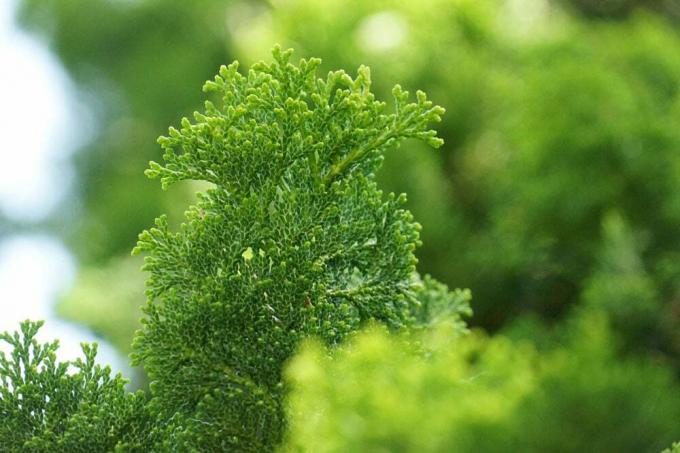
Red honeysuckle (Lonicera xylosteum)
- Honeysuckle family (Caprifoliaceae)
- native to Europe and Asia
- calcareous soil preferred
- nutrient-rich and permeable
- bright red berries from September
- deciduous shrub
- hardy
- fragrant yellow to white flowers
- Flowering time between May and June
- tolerates every location
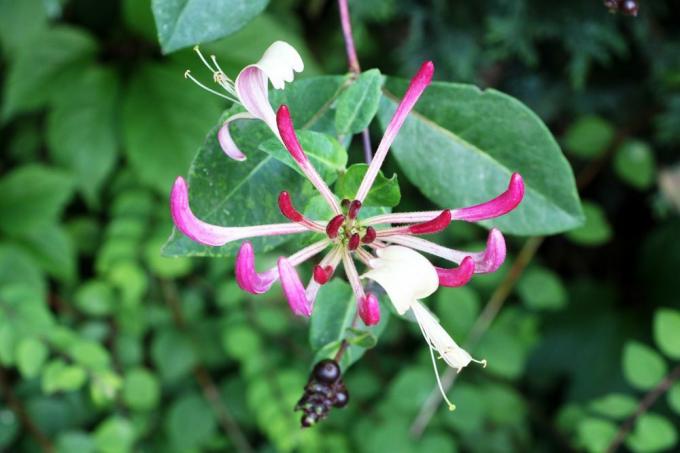
Cotoneaster (Cotoneaster)
- originally from Asia, Africa and Europe
- belongs to the pome fruit family (Pyrinae)
- from the rose family (Rosaceae)
- grows in breadth
- dense foliage with glossy, dark green leaves
- evergreen
- hardy
- Flowers in May and June
- Autumn yellow or red fruits
- calcareous soil is tolerated

tip: If you decide on year-round grave planting, you can also resort to plants that reflect life for reasons of mourning and sentimentality. Plants that the deceased particularly liked should also play a role in the planting.
Bulb plants
So that with the first warmth there is also a little color on the grave site early flowering bulb plants excellent for getting a spot in a corner or between the ground cover. Here they carefully raise their beautiful colored blossoms directly after winter. Suitable bulb plants include the following:
Crocus (crocus)
- Iris family (Iridaceae)
- incorrectly assigned to the bulbous plants
- about 90 species
- come mainly from Turkey and Greece
- some species also bloom in autumn
- five to fifteen centimeters high, depending on the species
- many different colors
- Tubers remain in the soil and multiply
- sunny to partially shaded location
- sandy, stony and loamy soil

Daffodil (Narcissus pseudonarcissus)
- also called the daffodil
- Amaryllis family (Amaryllidaceae)
- native to Western Europe
- between 40 and 60 centimeters high
- multiplies quickly
- one flower per stem
- Flowering period between March and April
- light shade is ideal
- fresh, moist, nutrient-rich soil
- Onions can remain in the ground
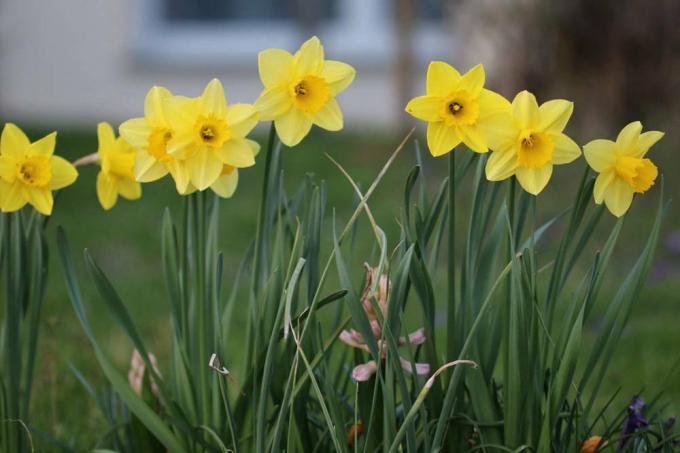
Tulip (tulipa)
- Lily family
- numerous species
- incompatible with summer drought
- this shortens the growing season
- Well drained soil
- Onions begin to rot in permanently moist soil
- always plant in groups
- Cut off dead flowers
- Let the leaves and stems dry out
- Onions can remain in the ground
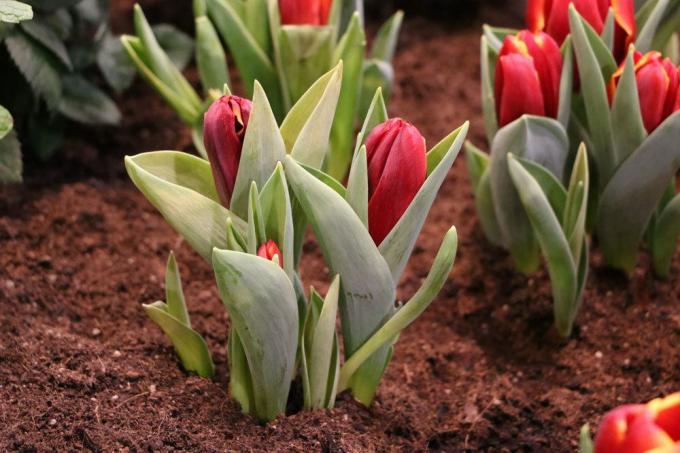
tip: If you put the bulb plants between the ground cover, you should pay attention to small gaps through which the spring bloomers can grow out immediately after winter. Because year-round ground cover often forms a closed cover that prevents weeds from growing forms, but also that the early onion plants do not stretch their green tips upwards can.
Perennials
So that it blooms a little in summer until autumn, you can choose hardy perennials that bring color to the grave plants later in the year. In the autumn before the first onset of winter, the plants are cut back completely close to the ground and then sprout again from the first warm temperatures. The hardy perennials that are also comfortable in the shade include the following:
from C - E
Chrysanthemums (Chrysanthemum)
- Asteraceae family
- originally native to East Asia
- 5,000 different varieties
- also winter asters
- Flowering in autumn
- many different colors
- Cut the perennials on a stick after flowering
- sprout again in spring
- Choose a hardy variety
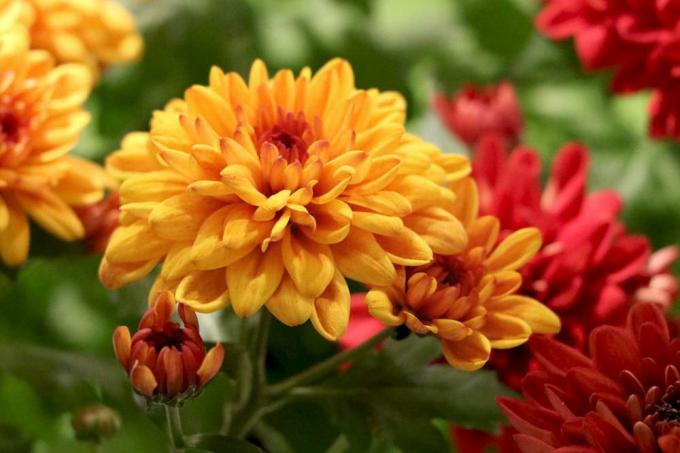
Monkshood (aconite)
- Buttercup family (Ranunculaceae)
- originally from Asia
- about 300 different species
- bright blue or yellow flowers
- sitting on upright panicles
- Flowering time from spring to autumn, depending on the species
- moist, nutrient-rich soil
- partially shaded location under trees
- toxic in all parts
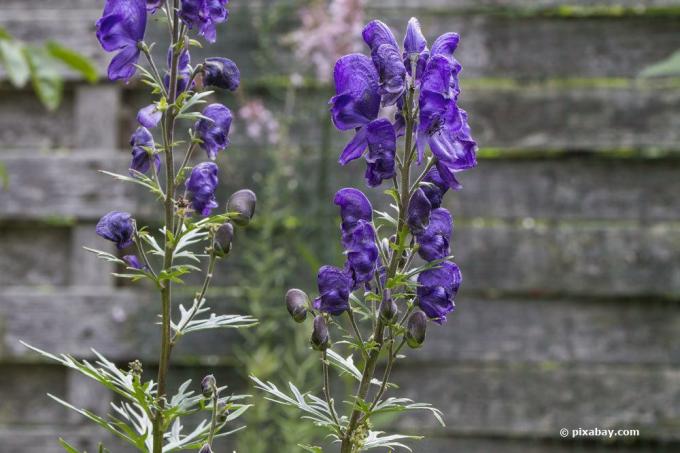
from F - H
Foxglove (digitalis)
- Plantaginaceae family
- red foxglove (Digitalis purpurea) native to local latitudes
- also foxweed or cinquefoil
- Name of flower reminiscent of foxglove
- multiplies by seeds themselves
- hardy
- biennial
- poisonous in all parts
- slightly moist, humus-rich, nutrient-rich and lime-poor soil
- no direct midday sun
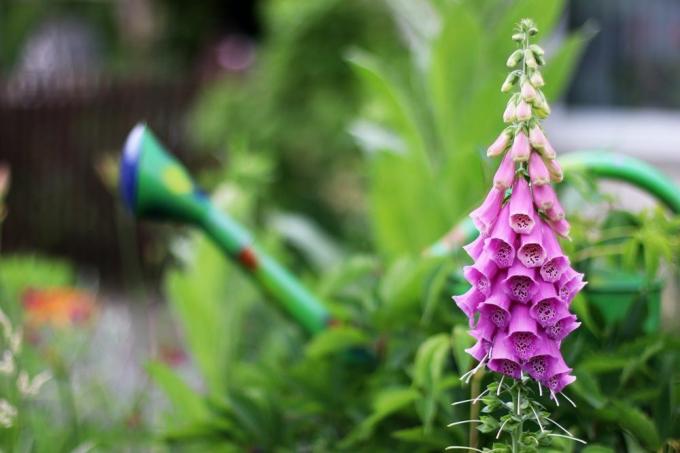
Hosta
- Asparagaceae family
- originally from China, Korea and Japan
- also heart lilies
- humic, evenly moist soil
- hardy grave planting
- large, decorative leaves
- golden yellow autumn colors
- easy-care grave planting
- purple or white pendulous bell flowers
- hardy

Autumn anemone (anemone)
- Buttercup Family (Ranunculacea)
- originally from China and Japan
- easy to care for and robust
- hardy
- Flowers from July until well into October
- simple to double flowers in different colors
- Light shadow location
- humus and nutrient-rich soil
- always keep moist in summer
- do not tolerate drought
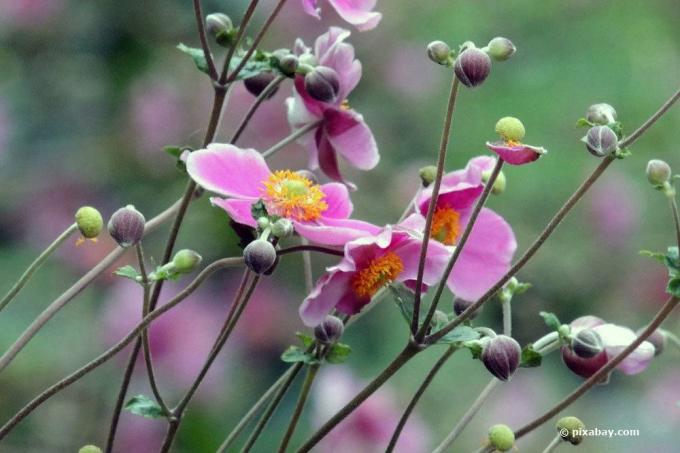
Note: Please note, however, that even if the plants presented require little care for the grave planting, they still need to be fertilized from time to time. In addition, water should be poured regularly even if the grave is in the shade in very hot and dry summers. However, year-round ground cover keeps the moisture in the soil longer.

